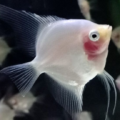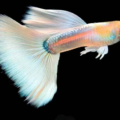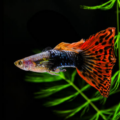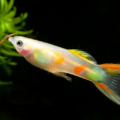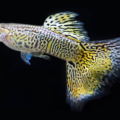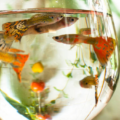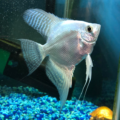Preserving the beauty and more of Mosaic Guppies by using the best aquarium care practices and health treatments for diseases.

The Colorful World of Mosaic Guppies
Why should you choose a Mosaic guppy fish for your tank? It’s a dazzling aquarium fish known for its striking, multi-colored patterns and majestic, flowing fins, making it an ideal option if you’re looking to brighten your waters.
Vibrant guppy varieties, like the mosaic types, have quickly become one of the most desired ornamental guppies for enthusiasts because of their kaleidoscopic scales and intricate designs.
There’s more to this eye-catching freshwater fish than its beauty, and that’s what I’m here to share with you today.
In this Mosaic Guppy overview, you’ll learn the means of identifying this species, the ideal tank setup guidelines, health and nutrition tips, and insights on choosing the most compatible tank mates.
Origins and Development of Mosaic Guppies
This fish’s vibrant patterns are a result of selective guppy breeding techniques dating back to the 19th century.
The evolution of guppy patterns came when aquarists and hobbyists started experimenting with genetics to create new and exciting color combinations from natural South American wild guppies.
Breeders picked the most desirable genetic traits in ornamental guppies to develop the mosaic coloration, and it was worth the challenge because, in no time, it became one of the most beloved variants of this species.
Several years after the development of Mosaic Guppy coloration, breeders continue pushing the boundaries. Here’s how to identify this unique aquarium fish.
Distinctive Physical Characteristics of Mosaic Guppies

The Mosaic Guppy physical traits are the selling point of this species, and that’s why they’re worth a closer look.
Although the Mosaic Guppy are interactive and social, their ornamental fish appeal lies in the intricate combination of colors and patterns on their scales.
A captivating, vibrant, multi-colored body and flowing fins characterize all mosaic guppies. Their kaleidoscopic guppy colors blend shades of blue, green, yellow, red, and purple, creating unique patterns for each fish.
Their striking guppy fin patterns stand out depending on the structure, which ranges from short lyretail to dramatic dumbo ears, Halfmoon, and delta tail. The combination of its unique coloration and fin structure adds to its majestic look, as the scales sometimes shimmer and reflect light.
If you like what you’ve seen so far, keep reading for more tips on preserving the beauty of the Mosaic Guppy.
Essential Care Guidelines for Mosaic Guppies
Mosaic Guppy care essentials are specifically designed to cater to their physical, health, and mental needs. So follow these guidelines carefully.
Water Parameters
Keeping optimal water parameters is important in maintaining water quality. The temperature should be between 72-82°F, pH between 6.8-8.5, and Hardness at 5-20 dGH.
Tank Size
The tank should be at least 10 gallons and should have decor like live plants, rocks, and driftwood.
Tank Maintenance
Other maintenance practices, like regular water changes, using high-quality filtration, and maintaining adequate spacing, help keep guppies healthy.
By following these guidelines, especially on tank maintenance for vibrant fish, you’ll create a thriving environment for your Mosaic Guppies. Now, let’s dive deeper into creating the ideal tank environment for your pets.
Creating the Ideal Tank Environment for Mosaic Guppies

The perfect guppy tank setup must be spacious enough to allow the fish to swim freely. Your ten-gallon tank should have a length of at least 20 inches and should be rectangle-shaped to suit your pet’s physical structure.
Decor and Filtration
Consider using colorful aquarium décor for your mosaic guppies to give your tank some life and boost your pet’s emotional health. Use your decorative set to replicate its natural waters so that it can grow and live as naturally as possible even though it’s out of the wild.
You can introduce high-quality filtration and plants for guppies, like Amazon swords, along with rocks and an open swimming area to showcase the fish’s colors.
Use a sponge filter to clean the waters and maintain its quality so that the Mosaic Guppy tank environment always stays optimal.
Before talking about the dangers of having leftover food in the water that causes health hazards, here’s a quick look at the kinds of food your pets eat.
Feeding and Nutrition to Enhance Coloration
A balanced Mosaic Guppy diet plan should include high-quality commercial flake or pellet food, live or frozen foods (bloodworms, daphnia), and Vegetable-based foods (spirulina or zucchini) as supplements.
You can include color-enhancing food for vibrant fish coloration, like vitamins, mineral supplements, and Omega-3 fatty acid supplements in your Mosaic’s diet.
For more on feeding your aquatic pets check out The Ultimate Guide to Fish Food: Pros and Cons & Best Choices!
Feeding Frequency
When feeding Mosaic Guppies, ensure you feed only quantities consumable in 1-2 minutes and twice to thrice daily.
A balanced and varied diet will ensure you meet the nutritional requirements of your fish, helping you maintain their optimal health, coloration, and well-being.
Follow this Mosaic Guppy nutrition guide to ensure you provide a varied and nutrient-rich diet that ensures your fish thrive and display their stunning colors. Now, you’re ready to learn about potential health diseases that come from poor nutrition and poor water quality.
Health Issues and Disease Prevention in Mosaic Guppies
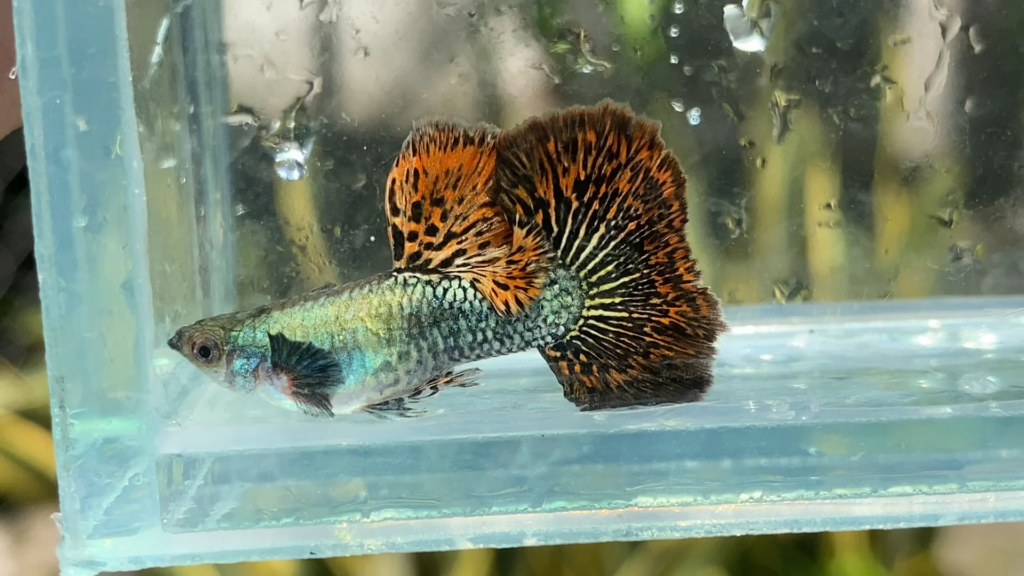
Many of the health challenges your Mosaic Guppy will face could come from your negligence. If you don’t follow the first part of this guide to a tee, that is, tank care and nutrition, you’re putting your pets at risk of environmental diseases.
But they can also get sick from genetic predispositions. Whatever the cause of their illness is, you can tackle them with some treatments.
That’s why I added this Mosaic Guppy health guide, which provides information, prevention tips, and relevant treatment strategies for your pets.
Fin Rot
This is one of the common guppy health issues. It is a bacterial infection causing fin erosion, fraying, or decay.
- Symptoms: Ragged/torn fins, Discoloration/redness, Lethargy, and Loss of appetite.
- Prevention: Maintain optimal water parameters (pH 6.8-8.5, temp 72-82°F), Perform regular water changes (25-50% weekly), and Avoid overcrowding.
- Treatment: Quarantine affected fish, Administer antibiotics, and ensure better water sanitation.
Ich (White Spot Disease)
This is a Parasitic infection causing white spots on the scales and fins of fish.
- Symptoms: White spots or patches, Scratching or rubbing, Lethargy and Loss of appetite
- Prevention Tips: Quarantine new fish, Maintain optimal water parameters, and Avoid stressing fish.
- Treatment: Quarantine affected fish, Administer antiparasitic treatments, and Increase water temperature (82°F).
For more details checkout our article on How to Treat Ich Outbreaks in Your Freshwater Fish!
Swim Bladder Disease
This disorder affects swim bladder function and causes buoyancy issues.
- Symptoms: Swimming difficulties, Floating or sinking, Lethargy and Loss of appetite
- Prevention Tips: Provide a varied diet, Avoid overfeeding, and Maintain optimal water parameters.
- Treatment: Quarantine affected fish, give fish salt baths, and feed food in small quantities.
Preventing guppy illnesses requires attention to water quality, diet, and environment, amongst other functions. Being proactive with guppy disease management is the best way to keep your pets healthy, whether it’s with preventive care or reactive medication.
Breeding Mosaic Guppies: Key Tips and Tricks
Do you want more Mosaic Guppy fish in your tank? Breeding vibrant Mosaic Guppies requires attention to detail and some patience because this species is a livebearer. That means they don’t lay eggs but free-swimming fry.
Selecting Ideal Breeding Pairs
Ensure you choose healthy, vibrant Mosaic Guppies with desirable traits. The selected pair should have complementary colors and patterns. Females should be mature, at least 6-8 months old, before making them breeders so that they’re healthy enough to carry the fry.
This video has been very helpful in identifying the sex of Guppies, I highly recommend it:
Creating Optimal Breeding Conditions
Use a separate breeding tank of 10-20 gallons with a water temperature of around 82°F and pH between 6.8-7.5. Consider common guppy reproduction strategies like mimicking their natural habitat by adding plants and hiding places for seamless results.
Breeding Process
Introduce the male and female to the breeding tank and monitor for mating, which usually occurs within 1-3 days. Providing optimal tank conditions during the breeding process is essential to raising colorful guppy offspring.
Caring for Fry
Separate fry from parents to prevent predation and provide nutrient-rich foods like infusoria and crushed powdered flakes. Ensuring proper nutrition from this stage is important in preserving guppy patterns in fry.
Strive to maintain optimal water parameters and monitor fry development. When they start getting larger, you can separate them by color and pattern or leave them in a colorful variety tank.

Mosaic Guppy’s social behavior is peaceful and gentle because of their delicate bodies. Considering insights into their social behavior helps you gauge their community tank compatibility.
Having a tank with suitable tankmates allows for harmonious tank dynamics, ensuring the fish thrives.
Suitable tankmates for Mosaic Guppies include Neon Tetras, Harlequin Rasboras, and Dwarf Gouramis.
When choosing tank mates for guppies, avoid fin-nippers and other aggressive or territorial fish if you want to maintain harmony in your aquarium.
Consider their temperament, size, other physical characteristics like fin structure and colors, and environmental needs. If the potential tank mates pass the test of matching with your Mosaic Guppy on those factors, you’ll create a foolproof community.
Conclusion
When adding vibrant guppies to your tank, ensure you provide them with a balanced diet and varied nutrients that will help them thrive.
The Mosaic guppy’s stunning scales make them an ideal variant for creating a colorful aquarium, but you’ve also learned that they have more to offer, such as their social personality.
To keep them thriving, follow the Mosaic Guppy care summary provided in this article and enjoy the beautiful array of their vibrant colors and majestic tails.
You have no excuse not to build a beautiful and healthy aquarium because these guidelines cater to guppy care for beginners and experts.

